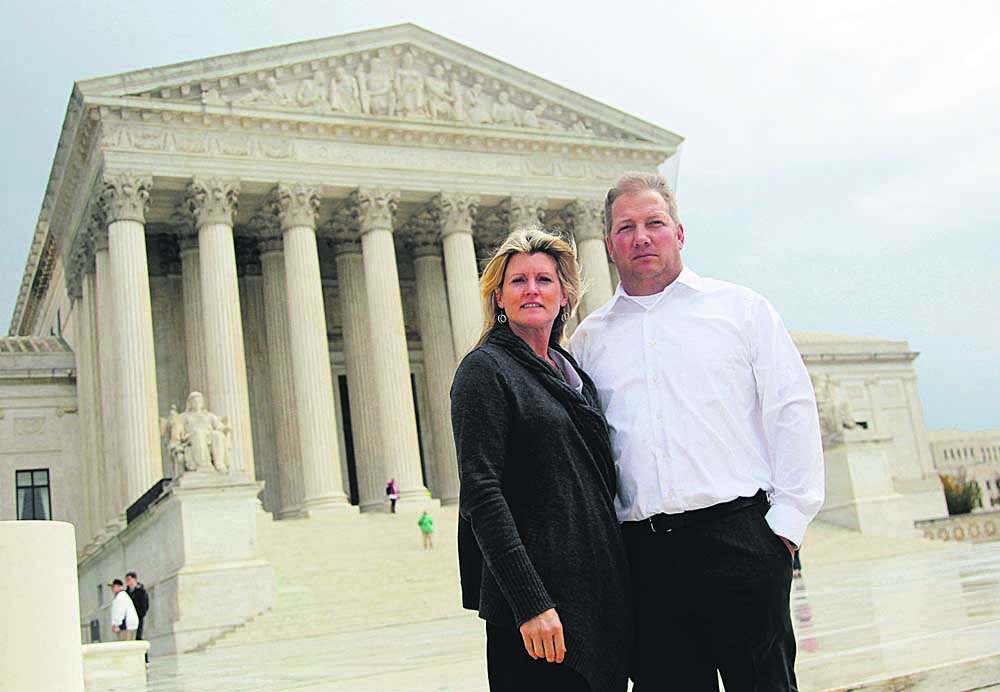9th Circuit rules against landowners in Clean Water Act dispute
Published 8:15 am Tuesday, August 17, 2021

- Mike and Chantell Sackett of Priest Lake, Idaho, stand in front of the Supreme Court in Washington, D.C. Their legal dispute with the federal government over wetlands will be reviewed by the nation’s highest court.
A federal appeals court has ruled against Idaho landowners who disputed that their property contains wetlands that can’t be filled without a Clean Water Act permit.
The lawsuit came to national attention nearly a decade ago, when the U.S. Supreme Court allowed Chantell and Michael Sackett to challenge a federal order that accused them of unlawfully altering wetlands to build a house near Priest Lake.
Though the Sacketts won that case, the 9th U.S. Circuit Court of Appeals has now agreed with the U.S. Environmental Protection Agency’s underlying decision that their property contains wetlands under Clean Water Act jurisdiction.
“In sum, EPA reasonably determined that the Sacketts’ property contains wetlands that share a significant nexus with Priest Lake, such that the lot was regulable under the CWA and the relevant regulations,” the 9th Circuit said.
The couple believes the 9th Circuit’s opinion is in error and is reviewing the ruling with its lawyers to decide how best to free the property from federal CWA authority, said Tony Francois, senior attorney with the Pacific Legal Foundation, a nonprofit law firm that represented the Sacketts.
The 9th Circuit’s reasoning could endanger other landowners in the West, including farmers, whose property comes under the ruling’s broad definition of a federally regulated wetland, Francois said. “It’s certainly not unique to the Sacketts.”
Under the ruling’s rationale, the EPA can “reach across fairly significant distances of dry ground” to claim that “any swampy soil on your property” is adjacent to a federal waterway and thus subject to CWA regulations, he said.
“The EPA’s own investigation found there is no surface flow between the Sackett’s lot and the lake,” Francois said. “They’re completely isolated from the lake.”
The Clean Water Act is controversial in agriculture because farmers fear that if their property is subject to the statute’s authority, they can be forced to limit the uses of their land unless they obtain an expensive and time-consuming permit.
In this case, the EPA issued a “compliance order” in 2007 demanding that the Sacketts restore the condition of their property, which had been backfilled with sand and gravel in preparation for construction, or face hefty fines for violating CWA.
The couple filed a lawsuit against the federal government, claiming the property didn’t contain regulated wetlands, but the case was dismissed because the EPA hadn’t yet formally sued the Sacketts or imposed civil penalties.
In 2012, the Supreme Court sided with the Sacketts and ruled that EPA’s compliance orders can be challenged in court because they’re final agency actions subject to judicial review.
The lawsuit was sent back to a federal judge, who ruled in 2019 that EPA correctly determined their property contains wetlands under CWA jurisdiction.
The 9th Circuit has now found “there was nothing arbitrary about EPA’s determination” that the Sackett property contains wetlands next to a federal waterway, since “artificial barriers did not defeat adjacency.”
In this case, that barrier was a road between the property and the tributary of a creek that flows into the lake.
The wetlands in question also have the required legal nexus with a federal waterway because they “significantly affect the integrity of Priest Lake,” providing “important ecological and water quality benefits,” the 9th Circuit said.






